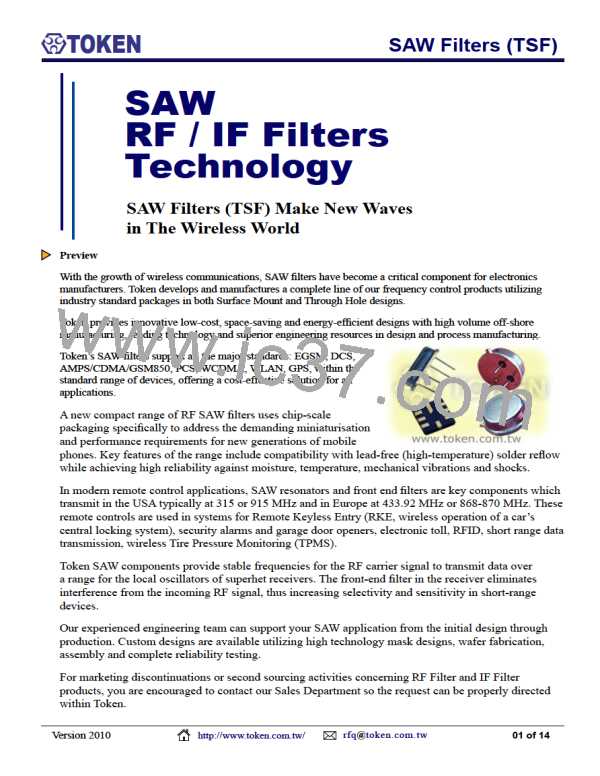RF & IF Filter Applications
TOKEN
RF & IF Filter Applications
RF Filters (front end)
●
- The main key factor of insertion loss on system performance criticizes the application of resonant
design principles such as LCRF (Longitudinally-Coupled Resonator Filter), IEF (Impedance
ElementFilter), and IEF balanced bridge filters. With many year’s experience in SAW applications,
Token takes advantages of these design principles for the development of low loss filters for front
end applications.
- A combination of two port resonators can be described as an LCRF design. Typically, a parallel
connection of 4 two port resonators is used. This advantage allows very low loss by reducing resistive
losses and avoided waveguide effects.
- IEF composes the basic design principle for RF filters with one port resonators used as impedance
elements. Resonators are constituted in a ladder configuration. The difference between the acoustic
impedance of resonance and anti-resonance is used to achieved a filter performance. The resonators
may be designed to have different resonant frequencies.
- For wide-band, low-loss filters, Token takes advantage of different cuts of higher coupling substate
material (LiNbO3 / LiTaO3).- TO-220 Style Power Package, Isolated Case, Non Inductive.
IF Filters
●
- There are various different design principles which are suitable for the design of IF SAW Filters.
However, to meet the requirements perfectly is working on optimization.
- Precision filter design meets most of the requirements such as phase ripple, group delay and low
amplitude in combination with high close-in rejection and fabulous selectivity. The disadvantage
of precision filters is their high insertion loss. Token SAW Resonator design makes low insertion
loss and miniaturized package size served better.
- SPUDT (Single Phase Unidirectional Transducer) filters combine transversal and resonant filter
design principles to take advantage of optimization both. By optimizing the transduction and
reflection of interdigital transducers, the filter performance can be improved while keeping the
chip size the same. As a result of internal reflections, the signal length in the time domain is increased.
- Token utilizes SFIT (Slanted Finger Interdigital Transducer) filter to provide a low insertion loss
with a wide bandwith in SAW design. Token has developed a set of practical design tools to achieve
low group delay ripple, and suppression of reflections including the triple transit signal.
Version 2010
rfq token.com.tw
http://www.token.com.tw/
13 of 14

 TOKEN [ TOKEN ELECTRONICS INDUSTRY CO., LTD. ]
TOKEN [ TOKEN ELECTRONICS INDUSTRY CO., LTD. ]